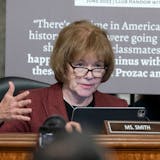Confronted with surging homelessness that's filling shelters and spilling into makeshift camps across the city, St. Paul and Ramsey County officials want to add 100 homeless shelter beds by winter, increasing the number of available beds in the east metro to more than 800.
City officials as of last week counted 380 homeless people living outside at dozens of makeshift camps across St. Paul, the highest number on record. The highest daily number of people the city recorded in camps last year was 26, and 30 people were counted sleeping outdoors in early March.
The city and county will rely on a pot of $37.9 million in state, federal and local funds to help address the surge in homelessness into the fall. More than half of that is from the federal Coronavirus Aid, Relief, and Economic Security (CARES) Act and must be used by year's end.
"These are unprecedented times. We have never seen these numbers in such a short period of time," said Ricardo Cervantes, St. Paul's director of safety and inspections.
Local leaders say the pandemic also has brought unprecedented resources to address the problem.
The number of people sleeping outside in St. Paul has spiked for a number of reasons, Deputy Mayor Jaime Tincher said. The pandemic and subsequent shutdown not only have created record unemployment, it closed doors to many who were surviving on the margins by couch-hopping with friends and family, Tincher said.
"As families practice social distancing, they sometimes pushed friends and family out of their homes," said Max Holdhusen, Ramsey County's housing stability manager.
A St. Paul spokeswoman said Wednesday that city officials were planning to clear an encampment of about 30 people Thursday morning near Interstate 35E and Kellogg Boulevard.


